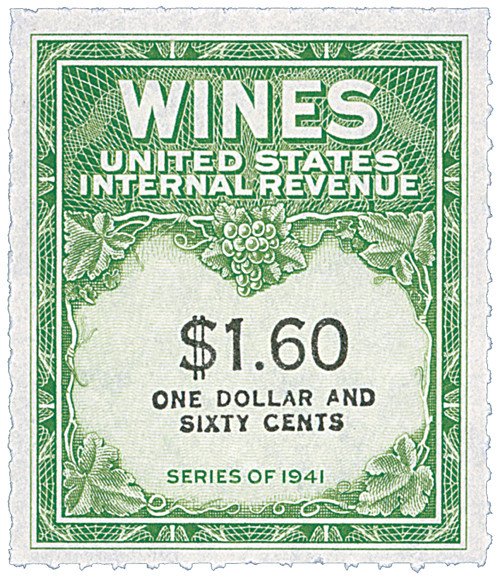
1949 $1 Cordials, Wines, Etc. Stamp,Engraved, yellow green & black
# RE173 - 1949 $1 Cordials, Wines, Etc. Stamp - Engraved, yellow green & black
$1.85 - $4.50
The Series of 1941 Revenue stamps contains 104 values, the longest in U.S. history. Issued as a result of the Revenue Act of 1941, the first stamps became available in February 1942. The last stamps of the series were produced in 1954.
The series also marks the first time standard backgrounds were used for stamps of different denominations. The rates changed four times over the course of the series, and there were four different types of wines that required stamps. New values were printed as they were needed with each change, saving money and time.
Wine Revenue stamps showed the appropriate tax had been paid on the product. The stamps could only be sold to proprietors of bonded wineries, store rooms and field warehouses.
Their use on bottles, railroad tankers and other containers was also heavily regulated. The stamps had to be affixed on the container securely in plain view, where they were exposed to weather and other harsh elements. Furthermore, winery proprietors were required to destroy the stamp when the containers were emptied.
Collectors were prohibited from owning Wine Revenue stamps until 1949, and even then it was difficult or impossible to find mint copies.
Additionally, some denominations were printed by the Bureau of Engraving and Printing, but never distributed by the Internal Revenue Service. The IRS transferred their supply to the Smithsonian Institution between 1954 and 1978. The stamps remained in the vaults of the National Postal Museum, part of the Smithsonian. Mystic was able to get a substantial number of mint Wine Revenue stamps when the museum put them up for sale.
The Series of 1941 Revenue stamps contains 104 values, the longest in U.S. history. Issued as a result of the Revenue Act of 1941, the first stamps became available in February 1942. The last stamps of the series were produced in 1954.
The series also marks the first time standard backgrounds were used for stamps of different denominations. The rates changed four times over the course of the series, and there were four different types of wines that required stamps. New values were printed as they were needed with each change, saving money and time.
Wine Revenue stamps showed the appropriate tax had been paid on the product. The stamps could only be sold to proprietors of bonded wineries, store rooms and field warehouses.
Their use on bottles, railroad tankers and other containers was also heavily regulated. The stamps had to be affixed on the container securely in plain view, where they were exposed to weather and other harsh elements. Furthermore, winery proprietors were required to destroy the stamp when the containers were emptied.
Collectors were prohibited from owning Wine Revenue stamps until 1949, and even then it was difficult or impossible to find mint copies.
Additionally, some denominations were printed by the Bureau of Engraving and Printing, but never distributed by the Internal Revenue Service. The IRS transferred their supply to the Smithsonian Institution between 1954 and 1978. The stamps remained in the vaults of the National Postal Museum, part of the Smithsonian. Mystic was able to get a substantial number of mint Wine Revenue stamps when the museum put them up for sale.












